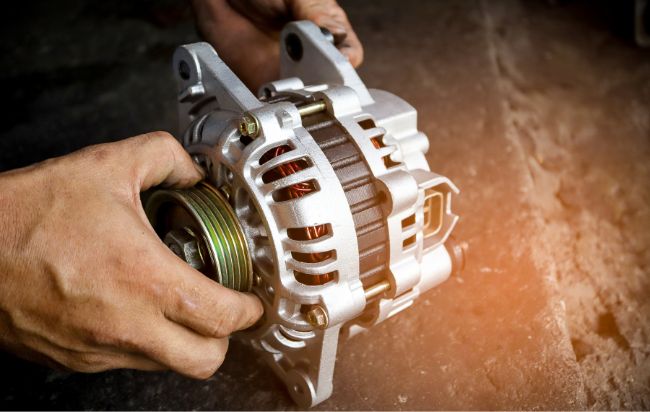
This component helps keep the battery charged. Scenarios like not running your car for weeks at a time or damage to the alternator can affect battery power.
How the Alternator Works
Your car has a charging system that consists of the battery, voltage regulator and the alternator, which is attached to the engine.
The alternator generates electricity for the battery and together, these components help power the rest of your vehicle. To do this, the crankshaft’s circular movement helps the alternator operate, which sends alternating current (AC) power to the battery. This provides sufficient voltage to the rest of the vehicle’s electrical systems, including the lights, air conditioner and windows.
The alternator also has multiple circuit connecting points on the rear. These monitor the amount of power the vehicle has to activate the voltage regulator and close the circuit path to the car’s warning lamp. Meanwhile, vents help the alternator manage heat output.
Thinking about the combustion process as a whole, the alternator and battery deliver enough power to the spark plugs so they ignite the fuel put into the car. If the circuit connecting points experience damage, the alternator can’t sense the amount of power the battery supplies.
Signs of a Damaged Alternator
With sufficient maintenance, most alternators last 10 to 15 years. However, parts that come loose or no longer function as they should alter the relationship among the charging system’s components. This can materialize as the following:
- Flickering or dim headlights mean your battery isn’t getting enough power from the alternator.
- A battery that dies before the three to five-year mark or that needs to be charged frequently can be the result of a damaged alternator.
- Stalling after you start up your car or as you’re driving can indicate the alternator isn’t fully charging the battery.
- A slow start, in which the engine doesn’t fully turn over or the car turns off once the engine ignites can indicate the alternator and battery aren’t supplying enough power to the spark plugs.
- Strange sounds like rattling, growling or whining can indicate the alternator isn’t supplying the engine with sufficient power.
- A burning rubber smell is often a sign of an overheating alternator. However, it can also mean the part has a damaged drive belt or wires.
- Additional electrical issues, including systems that don’t turn on or run sluggishly or inconsistently can be a sign the alternator isn’t charging the battery all the way. The windows, headlights, air conditioning and locks are frequently affected.
- The “GEN” or battery light illuminates on the dashboard if the battery has a low charge, including if the alternator isn’t supplying enough power.
- The serpentine belt may have become loose, which helps power the alternator.
Servicing the Alternator
If you notice any of the above signs, avoid driving for the time being. You won’t get very far, as the battery will quickly lose its charge.
To determine if your car is experiencing a battery or alternator issue, our technicians will first examine the electrical and charging systems and conduct diagnostic tests. If the battery can charge up, the car likely has an old, worn or damaged alternator or a starter. Based on the degree of damage, we may recommend repairing or replacing the part affecting the power delivered throughout your vehicle.
If you’re concerned about the performance of your car’s alternator or battery, contact our Naugatuck shop to make an appointment for diagnostic testing and repair services.

